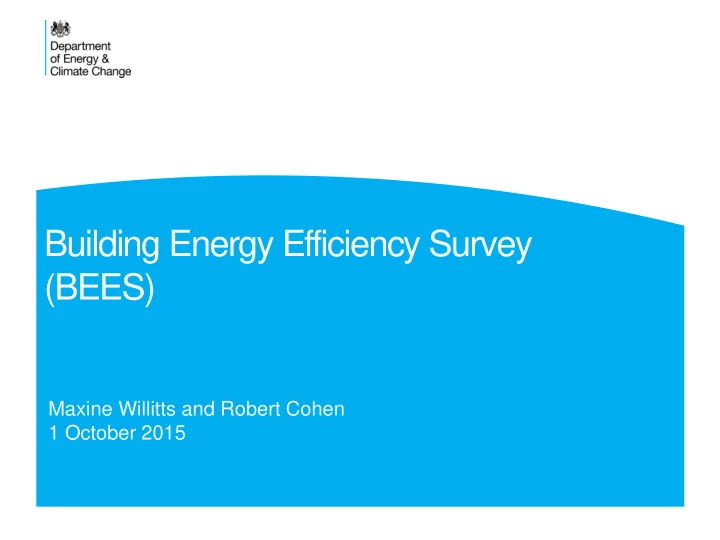

Building Energy Efficiency Survey (BEES) Maxine Willitts and Robert Cohen 1 October 2015
Overview • Why does BEES matter? • Research aims • Scope • Methodology • Survey • Modelling 2 Building Energy Efficiency Survey (BEES) Project
Why does BEES matter? • Economic studies show that improved energy efficiency can save money, bolster productivity, increase growth, reduce inflation and improve health outcomes. • The energy use of UK non-domestic buildings is responsible for 12% of UK end-use greenhouse gas emissions (non-domestic buildings use 25% of all energy consumed). • Currently, DECC relies on data collected in the 1990s in the Non-Domestic Energy and Emissions Model (N-DEEM), to provide information on energy end-use in non-domestic sectors. • As an important user of energy and contributor to emissions stronger up to date and accurate evidence of energy use in this sector is needed to inform DECC’s important strategic decisions. 3 The Building Energy Efficiency Survey and Why it Matters
Research Aims Aim: • Update the evidence base for energy use and abatement in Non- Domestic buildings across England and Wales Research Questions: • Update understanding of how energy is used (for different end uses in each building type and in aggregate), for a snap-shot in time • Update understanding of how energy use can be abated • Understand qualitatively the barriers and facilitators of energy abatement 4 Building Energy Efficiency Survey (BEES) Project
Scope Floor area (m 2 ) by sector Cum. Floor area (m 2 ) by subsector ( Adapted from UCL, 2012) ( Adapted from UCL, 2012) 5 Building Energy Efficiency Survey (BEES) Project
Scope Sector Sub-Sector Sector Sub-Sector Nursery Small Shops (Food & Non-Food) Primary School Large Shops (Food & Non-Food) (>750m2) Education Secondary School Hypermarket/Superstore (>2,500m2) Retail University (residential & non-residential) Showrooms (Vehicle & Non-Vehicle) Health Centres Retail Warehouse Health Hospitals (NHS & Private) Hairdressing/Salon Police Stations Community Halls Community Prisons Places of Worhsip Emergency Services Courts Nursing Home Fire/Ambulance Stations Libraries/Museums/Galleries Leisure Military MOD Buildings Theatres/Cinemas/Concert Halls Commercial Offices (inc Central & Local Gov) Clubs (not sports) Offices Sports Sports Centres (with/without pools) Restaurant Stores, Warehouses Storage Pub Cold Stores Hospitality Hotel Workshops Takeaway Factories & Industrial Buildings Factories Café Large Industrial Buildings 6 Building Energy Efficiency Survey (BEES) Project
Methodology • Informed by 2013 pilot study into different methodology options Component Purpose - 20-25 minutes - Aimed at Energy/Facilities managers 4,000 Telesurveys - Collects basic data on building, equipment, usage & energy management - 'Core' questions and 'Sector Specific' questions tailored to building type - Recruited from telesurvey respondents - 0.5 - 1.5 days depending on building type/complexity 300 Site Audits - Validates data and collect more detailed building energy data and is basis for abatement calculation - 1hr qual interview on barriers and drivers to Energy Efficiency - Converts Survey answers into estimate of consumption via end use (heating, lighting, cooling etc.) Modelling - Calculates abatement & grossing 7 Building Energy Efficiency Survey (BEES) Project
Methodology - Survey • Ownership arrangements • Occupancy of premises • Space Activities • Screening Organisation Building Working practices Screening • Age and structure • Dates of recent renovations • Existence of external area • Organisation size • business activity • Metering and billing systems • Energy information including Sector Specific • Heating systems Exceptional Uses Building Services • Ventilation systems Questions • Lighting • Existence of exceptional energy uses KEY • Existence of low carbon/renewable energy Not tailored by subsector Energy Follow on Management Limited tailoring • • Recruitment for Site Surveys Energy management systems • Organisational energy management Complete tailoring 8 Building Energy Efficiency Survey (BEES) Project
Modelling • Energy intensity is defined & calculated on a space by space basis & aggregated to building level • Based on a floor area breakdown of m 2 of each space type (50-60 in model) • Each space type is a dataset of tree diagram parameters for each energy end use & servicing level 9 Building Energy Efficiency Survey (BEES) Project
Building Energy Hypothesis Model • The model uses a tree diagram basis to generate an energy use prediction at an end use level of resolution (26 end uses heating, lighting, ventilation, etc.) • The hypothesis calculation shares a common basis with the energy calculations used to generate predictions from survey responses. • Abatement calculation through manipulation of tree diagram variables. BEES - Modelled End Uses Lifts Heating Catering Hot water Distributed catering electric Space cooling Cooled storage Ventilation Entertainment lighting Pumps Entertainment equipment Controls Laundry electric Humidification Medical Internal lighting Questions Laboratory Display Lighting on lighting Pool/leisure External lighting type (e.g. Other Normal Small power LEDs) ICT equipment Questions on usage & controls 10 Building Energy Efficiency Survey (BEES) Project
Methodology – energy prediction & abatement BEES fieldwork Final Create “Iconic” Dataset Telesurveys building • summary insight • Space type breakdown Site surveys • End uses Grossing • Verification Calculations • Detailed insight • Abatement inputs • Barriers interview Processed Calibrate telesurvey Initial (vs. DEC/NEED) Final records Hypothesis Calibrate • Existing Hypothesis • End use model (vs. BEES Abatement benchmarks model breakdown fieldwork) Measure • Abatement Inventory potential Preliminary Processed iconic energy telesurvey prediction Calibrate Abatement records (vs. BEES Calculations • End use site breakdown surveys) Applicability of measures 11 Building Energy Efficiency Survey (BEES) Project
Next steps • The project has been in the field since summer 2014 with fieldwork nearing completion . • Currently undertaking a range of quality assurance activity including comparison to non-domestic NEED consumption data together with “shadow” modelling by using a University’s model. • Need to disclosure check results as some sites will be influential, some sub-sectors are based on small samples and some organisations contribute a high proportion of sites in some sub- sectors. • Plan to publish full report together with sector specific reports by Spring 2016. 12 Building Energy Efficiency Survey (BEES) Project
Recommend
More recommend